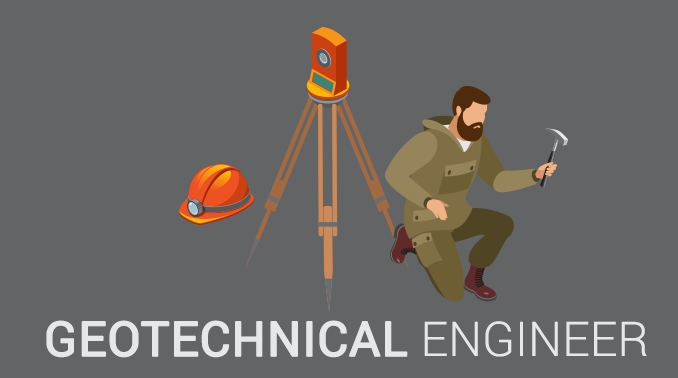Everything about Geotheta
Table of ContentsGeotheta Can Be Fun For AnyoneA Biased View of GeothetaThe Main Principles Of Geotheta Some Known Facts About Geotheta.
They collaborate with civil engineers, structural designers, engineers, and various other specialists to integrate geotechnical considerations right into the overall project layout and building and construction procedure. This needs efficient synergy, coordination, and interaction to make certain that the geotechnical elements line up with the job objectives and meet regulatory needs.Mining & Materials Engineering: Concepts of drilling, infiltration rates, and variables impacting the choice of drilling approach. Qualities of explosives, firing systems and blast patterns. Blowing up strategies in surface area and underground functions. Special blowing up methods at excavation borders. Vibration and noise control. Mechanical and continuous techniques to fragmentation, consisting of longwall shearing and fullface boring.
Integrated analysis of fragmentation and comminution operations. Supplied by: Mining & Products Engineering.
Some Known Facts About Geotheta.
Bachelor's degree programs in civil, geotechnical, geological, and ecological design typically last 4 years and consist of basic education and learning courses in English, social science, and the humanities, as well as programs in sophisticated mathematics, structural geology, and fluid mineralogy. (https://filesharingtalk.com/members/599923-geotheta)
Geotechnical design entails the evaluation of the dirt and rock conditions at a specific website, and their implications for the growth of that site. As many structures rely upon the ground for support, it is without surprise that an in-depth understanding of the ground problems, and the viability of foundation systems, are essential to the long-term stability and performance of the structure or structure.
Specialising in the investigation of geological developments and ground behavior, geotechnical engineers execute clinical investigations and screening to recognize the influence these geological formations may have on the style and building and construction of structure, civil and infrastructure tasks. This proficiency is critical for the design and building of buildings, roadways, tunnels, dams, bridges, and water system and sewage systems.
The geotechnical group at Douglas Partners routinely consult with engineers, layout engineers, developers, and builders to make suggestions on design and development proposals to guarantee that the developed frameworks are suitably designed for the ground conditions. For instance, the style of footing systems requires to take into consideration the weight of the framework, the capacity of the ground to sustain that weight along with motion resistances and reliable building and construction.
Geotheta Fundamentals Explained
This task is substantially simplified by the use our Douglas Map geospatial system that makes this information conveniently available in a simple to utilize internet browser interface. A geotechnical designer will certainly direct the exploration of boreholes and test pits to accumulate soil and various other examples, and likewise evaluate surface area attributes and ground exposures to form a geotechnical version of the subsurface problems.
Relying on the project kind and ground problems encountered, lab screening may to name a few points examine stamina, compressibility, reactivity and/or leaks in the structure of dirt and rock samples. After this information is collected and collected, the results are utilized for a geotechnical version of the website, which is generally offered as sections across the website.

A geotechnical examination naturally can only analyze the ground problems at the places drilled or dug deep into. Natural variations in dirt and rock problems can happen across a website and in between test locations. It is for that reason excellent practice that the geotechnical engineer be preserved throughout building of the task to supply on-site confirmation that the ground problems encountered are constant with the assumptions and recommendations offered in the geotechnical investigation record.
See This Report on Geotheta
Geotechnical designers use their thorough understanding of soil and rock to evaluate threat and fix troubles on diverse framework projectsGeotechnical design is a specialist branch of civil engineering which takes a look at the behavior of planet materials and the application of soil and rock technicians. Tailings Engineer. As a geotechnical engineer, you will certainly examine the physical, mechanical and chemical residential properties of soil and rock in order to make foundations, keeping frameworks and earthworks
Geotechnical engineering is carefully connected to and overlaps with, both design geology and ground engineering - https://www.slideshare.net/ianhammond2191. It's possible to specialise in geotechnics or help a geotechnical firm yet be referred to as an engineering rock hound or a ground designer. As a geotechnical designer, you'll need to: build and keep connections with customers and other professionals entailed in the site, throughout each projectmaintain safety standards on website bear in mind cost implications when you make recommendationsstudy geological maps and airborne pictures from a series of sources and from various time periodsexamine building plans to see just how practical they are based on your understanding of the siteinvestigate threats or geological threats for the sitesearch for ecologically sensitive functions, such as garbage dump begin to develop valid and interpretive ground modelsplan area investigationsdrill and analyse examples of bedrock, soil, groundwater and added products monitor other specialists on sitesolve technological problems as they occur, such as unanticipated structures at drill sitesmonitor problems during and after building and construction to see to it structures are stable in the brief and long termadding information collected on site to your first researchcreating geotechnical computations, illustrations, and two or three-dimensional computer system models analyzing the datamaking recommendations concerning the proposed use the website
